Sheet metal joining operation is crucial part of the sheet metal fabrication process. Joint reliability depends on its type, sheet metal material, and manufacturing process. This article covers various types of sheet metal joining techniques, their advantages, disadvantages, and applications.
Factors affecting the selection of type of Sheet Metal Joint
Selection of the type of sheet metal joint has an impact on product design, manufacturing cost, assembly process, joint reliability, and performance. The following factors affect the selection of the sheet metal joining process.
- Required Joint Type: Permanent or Temporary Joint
- Product Application
- Assembly Process
- Material Type
- Sheet Thickness
Various Types of Sheet Metal Joining Techniques
Following types of sheet metal joining techniques are available to join sheetmetal parts. Each joining method has its advantages, limitations, and applications.
- Screw Joints
- Rivet Joints
- Clinching Joint.
- Welding Joint
- Folding / TAB Sheet Metal Joints
- Adhesive Bonding
1. Screw Joint in Sheet Metal
Screw Joint is a type of temporary joint. Screws, bolts, nuts, studs, and standoff are used for fastening sheet metal parts. Click this link to know the difference between bolt and screw.
Types of screw joints
Following two types of screws are widely used to fasten sheet metal parts according to product design and functional requirements.
Machine Screws
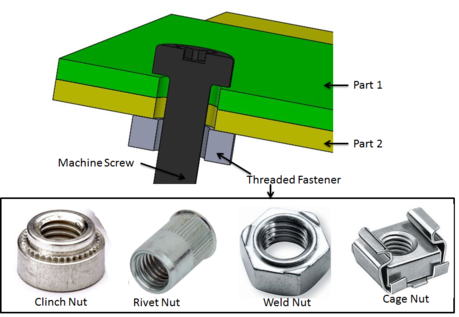
Machine screws have an application where we require multiple assemblies and disassembly operations. These screws require additional hardware such as clinch, riveted, or weld nuts on sheet metal parts.
Self Tapping Screw
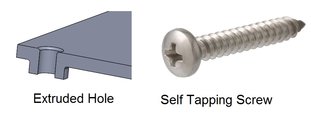
Self Tapping Screws are a low-cost solution for the one-time assembly of sheet metal parts. They require a pilot or extruded hole in one of the sheet metal parts.
Selection of the Type of Screw / Fasteners for Sheet Metal Joint
The following factors affect the selection of the type of screw to join sheet metal parts.
Sheet Metal Material
Experts recommend self-tapping fasteners for hard materials ( CRCA, SS), whereas machine screws are the best choice for softer materials such as Aluminum.
Sheet Thickness
Self tapping screws require larger sheet thickness to engage the recommended number of threads.
Assembly Approach
Machined screws have an application for multiple assembly and disassembly of the product, whereas experts recommend self-tapping for one-time product assembly.
Cost Constraints
Machine screws solution is costlier than self tapping screws.
Structural Requirements
Machine screws provide high clamping force compared to self tapping screws.
Advantages of Screw Joints in Sheet Metal
Using screw joints to join sheet metal parts has the following advantages.
- Temporary joints.
- A blind Joint is possible.
- A wide variety of fasteners are available for various applications.
- Highly reliable compared to other sheet metal joining techniques.
- Easy to assemble.
Disadvantages of Screw Joints in Sheet Metal
Along with so many advantages, screw joints come with the following limitations.
- Machine screws require additional fasteners such as nut, and standoff.
- Gaskets are required to achieve a waterproof joint.
2. Rivet Joints
Riveting is a type of permanent joining operation. It requires adjacent holes in the sheet metal parts.
Rivet Joining Process in Sheet Metal Parts
The rivet installation process involves placing the rivet inside the punched/drilled hole in the sheet metal parts. Afterward, the rivet mandrel is pulled against the rivet head using a riveting machine.
It results in diametrical expansion of rivet pin against sheet metal part and rivet head. The above process secures the sheet metal parts and rivets in position.
Types of Rivet
We can classify rivets into the following types according to rivet structure and the installation process.
- Solid or round head rivets
- Semi-tubular rivets
- Oscar rivets
- Blind or Pop Rivets (commonly used in the sheet-metal industry)
- Drive Rivets
- Flush type Rivets
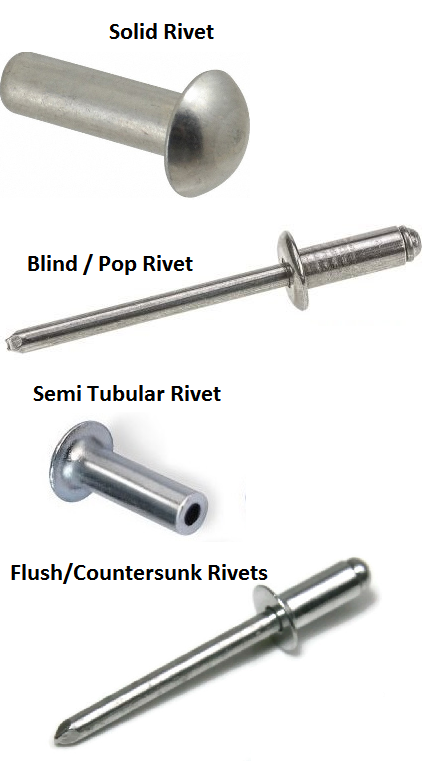
Advantages of Riveting in Sheet Metal Parts
Rivet joints in sheet metal have the following advantages.
- Low operational and material costs.
- Blind joints are possible.
- Part disassembly can cause minor damage to the part.
Advantages of Riveting in Sheet Metal Parts
Rivet joints in sheet metal have the following limitations.
- Higher stress concentration near the riveted area.
- The riveting setup is required.
3. Sheet Metal Clinching Joint
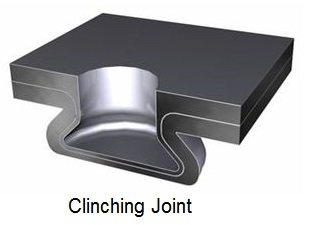
A clinching joint is a type of permanent sheet metal joining operation using a cold forming operation. It creates a button-type positive connection between two or three layers of sheet metal.
Clinching operation has application to join different material and sheet thickness parts.
Advantages of Clinching Joints
Clinching joints in sheet-metal have the following advantages.
- Additional fasteners are not required.
- Permanent joint.
- Low operational cost.
- Can join different materials and different thicknesses parts.
Disadvantages of Clinching Joints
- High initial setup cost.
4. Welding Joints
Welding is a type of permanent joining operation. Following welding techniques are used to join sheet-metal parts.
- MIG Welding
- TIG Welding
- Arc Welding
- Gas Welding
- Spot Welding
- Seam Welding
- Brazing
Factors affecting the selection of welding process
You should consider the following points during the selection of welding operations for an application.
- Sheet metal material.
- Sheet Thickness.
- Final Finish Requirements.
- Airtight or waterproof joint requirements.
- Working temperature Range.
Advantages of Welded Joints in Sheet Metal
Using welding to join plastic parts has the following advantages.
- Permanent Joint.
- Create Leak-proof joints.
- High load-carrying capacity.
- Welding of complex shapes is possible.
Disadvantages of Welding Joints in Sheet Metal Parts
Welding joints have the following limitations.
- Material properties changes near the welded area.
- Welded joints are difficult to inspect.
- Welding in thin metals can cause warping and burn-through.
5. Folding / Tab Joints in Sheet Metal
Folding or bending tabs is an economical way of making permanent sheet metal joints.
We can do this process on sheet metal bending machines. Therefore it does not require an additional hardware setup. Tab joints have application in joining soft steel, aluminum, copper, and brass materials.
Advantages of Folding Joint
Folding tab joints has the following advantages.
- Additional fasteners are not required.
- Low cost and reliable permanent joint.
- Joining dissimilar materials.
Disadvantages of Forming Joint
Folding tab sheet metal joints have the following limitations.
- Can achieve waterproof joints.
- Require a relatively long joint area to achieve the required strength.
6. Adhesive Bonding for Sheet Metal Parts
Adhesive bonding is a type of permanent joint used in sheet metal parts. You can disassemble parts using chemicals. For adhesive bonding, you need to place the adhesives between the part surfaces, and afterward, pressure is applied.
Factors affecting the selection of adhesive
You should consider the following points during the selection of adhesives for your application.
- Part Surface Geometry
- Part Material.
- Bonding strength requirement
- Moisture or water content in the working environment
Types of Adhesive
Following types of adhesives are available to join sheet metal parts.
- Cyanoacrylate Adhesives.
- Acrylic-based adhesives.
- Epoxy-based adhesive.
- Silicon-based adhesive.
Adhesive Joint Examples
Following are the two types of adhesives available for sheet metal joints:
- Double-Sided tapes: Double-sided tapes in various thicknesses and chemical compositions are available. We can select the adhesives as per design requirements.
- Liquid Adhesives: Adhesives in a liquid state with different viscosity and chemical compositions are available.
To sum up, the selection of the type of Sheetmetal joint (Permanent or Temporary) depends on product design requirements and its application.
We will keep updating various types of sheet metal joints. Add your comments, suggestions, or questions on sheet metal joining techniques in the comment box. We suggest you also read this article on sheet metal bending operations.

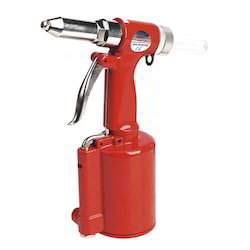
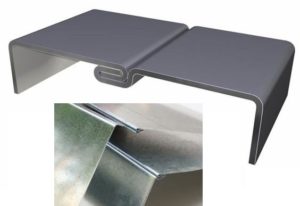
This site is very beneficial for me. Through this i get know about rivets. There is much briefly knowledge of rivets.